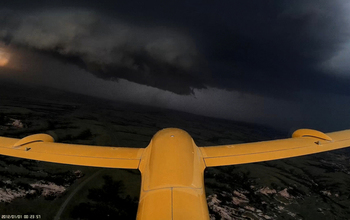Multimedia Gallery
TTwistor3 drone approaches supercell thunderstorm
A drone named TTwistor3 approaches a supercell thunderstorm in southern South Dakota during the "Targeted Observation by Radars and UAS of Supercells" study.
More about this image
Atmospheric scientists at the University of Nebraska-Lincoln and three partner institutions -- Texas Tech University, the University of Colorado Boulder and the National Oceanic and Atmospheric Administration's National Severe Storms Laboratory -- will soon launch the most ambitious drone-based investigation of severe thunderstorms to date.
For the study, which is called TORUS, for "Targeted Observation by Radars and UAS of Supercells (TORUS)," researchers will use radar and unmanned aircraft systems (UAS) to reveal the small-scale structures in a supercell storm that contribute to tornado formation. Scientists hope to reduce the number of "false alarm" tornado warnings and improve detection of potentially lethal storms.
"To understand how tornadoes are formed, we need to study their parent storms, called 'supercells,'" said Chungu Lu, a program director in the National Science Foundation's (NSF) Division of Atmospheric and Geospace Sciences, which is funding the project. "In TORUS, scientists will deploy a suite of radars and drones to observe supercells. The results will increase our ability to forecast tornadoes."
[This photo was taken during a field experiment supported by the NSF National Robotics Initiative (grant IIS 1527919).]
Read more about this award in the NSF Discovey story Tracking a supercell thunderstorm across the Great Plains. (Date image taken: June 2018 date originally posted to NSF Multimedia Gallery: May 16, 2019)
Credit: Integrated Remote and In-Situ Sensing (IRISS), University of Colorado Boulder
Images and other media in the National Science Foundation Multimedia Gallery are available for use in print and electronic material by NSF employees, members of the media, university staff, teachers and the general public. All media in the gallery are intended for personal, educational and nonprofit/non-commercial use only.
Images credited to the National Science Foundation, a federal agency, are in the public domain. The images were created by employees of the United States Government as part of their official duties or prepared by contractors as "works for hire" for NSF. You may freely use NSF-credited images and, at your discretion, credit NSF with a "Courtesy: National Science Foundation" notation.
Additional information about general usage can be found in Conditions.
Also Available:
Download the high-resolution JPG version of the image. (972.4 KB)
Use your mouse to right-click (Mac users may need to Ctrl-click) the link above and choose the option that will save the file or target to your computer.



 All images in this series
All images in this series